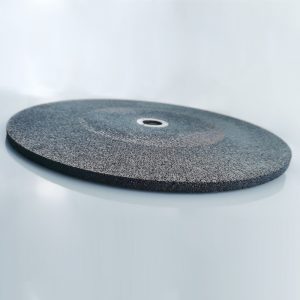What is the best cut-off wheel for fiberglass?
What is the best cut-off wheel for fiberglass?
Fiberglass is a versatile composite material used in various industries for its lightweight, durable, and corrosion-resistant properties. When it comes to cutting fiberglass, selecting the right cut-off wheel is crucial for achieving precise cuts, minimizing fiber damage, and ensuring safety and efficiency.

Understanding Fiberglass:
Fiberglass, also known as glass-reinforced plastic (GRP) or glass-fiber-reinforced polymer (GFRP), is a composite material composed of fine glass fibers embedded in a resin matrix. It is valued for its strength-to-weight ratio, corrosion resistance, and versatility, making it suitable for a wide range of applications, including construction, marine, automotive, aerospace, and manufacturing.
Factors to Consider When Choosing Cut-off Wheels for Fiberglass:
1. Material Compatibility:
– When selecting a cut-off wheel for fiberglass, ensure that the wheel is compatible with both the glass fibers and the resin matrix to avoid damaging or delaminating the material. Fiberglass is a brittle material that requires special care and consideration during cutting to prevent fiber breakage and splintering.
– Choose cut-off wheels specifically designed for cutting fiberglass or other composite materials, as these wheels are engineered to provide efficient cutting while minimizing fiber damage and surface chipping.
2. Abrasive Material:
– Cut-off wheels for fiberglass are typically made of abrasive materials such as silicon carbide, aluminum oxide, or diamond. These abrasive materials offer different cutting efficiencies, durability, and performance characteristics, depending on the application and material properties.
– Silicon carbide cut-off wheels are well-suited for cutting fiberglass due to their hardness, wear resistance, and ability to maintain sharp cutting edges. Aluminum oxide wheels are also effective for cutting fiberglass, while diamond wheels provide superior cutting performance and longevity.
3. Wheel Type and Design:
– Cut-off wheels for fiberglass are available in various types and designs, including reinforced grinding wheels, diamond blades, and abrasive cutoff wheels. Each type of wheel is tailored to specific applications and provides unique benefits and performance characteristics.
– Reinforced grinding wheels are suitable for heavy-duty cutting and grinding tasks on fiberglass surfaces, while diamond blades offer precise and efficient cutting with minimal fiber damage. Abrasive cutoff wheels are designed for clean, fast cuts in fiberglass panels, sheets, and components.
4. Grit Size:
– Cut-off wheels come in different grit sizes, ranging from coarse to fine, to accommodate various material thicknesses and cutting requirements. Coarser grits (lower numbers) are suitable for rapid material removal and cutting thick sections of fiberglass, while finer grits (higher numbers) are preferred for smoother cuts and thinner materials.
– Consider the thickness and density of the fiberglass material when selecting the grit size of the cut-off wheel. Coarser grits may be more suitable for cutting thicker and denser fiberglass, while finer grits are preferred for thinner and more delicate materials.
5. Wheel Diameter and Thickness:
– Cut-off wheels for fiberglass are available in different diameters and thicknesses to suit different cutting machines, applications, and material thicknesses. Standard wheel diameters range from 4 to 14 inches, with thicknesses typically ranging from 1/16 to 1/4 inch.
– Choose the appropriate wheel diameter and thickness based on the size of the cutting machine and the specific requirements of your fiberglass cutting task. Thicker wheels provide increased stability and durability, while thinner wheels offer greater flexibility and maneuverability.
Types of Cut-off Wheels for Fiberglass:
1. Reinforced Grinding Wheels:
– Reinforced grinding wheels, also known as bonded abrasive wheels, are commonly used for cutting and grinding fiberglass materials. These wheels feature abrasive grains bonded to a reinforced backing material, such as resin, vitrified, or metal bonds, to provide high cutting efficiency and precision.
– Choose reinforced grinding wheels with silicon carbide or aluminum oxide abrasive materials for cutting fiberglass. These wheels are available in various diameters, thicknesses, and grit sizes to suit different cutting applications and material thicknesses.
2. Diamond Blades:
– Diamond blades are specialized cut-off wheels featuring synthetic diamond particles bonded to a metal matrix or segment. These blades offer exceptional hardness, wear resistance, and cutting performance, making them ideal for cutting fiberglass, concrete, masonry, and other hard materials.
– Choose diamond blades with high-quality diamond segments and bond systems optimized for cutting fiberglass. Segmented diamond blades are preferred for dry-cutting applications, while continuous-rim diamond blades are suitable for wet-cutting operations.
3. Abrasive Cutoff Wheels:
– Abrasive cutoff wheels, also known as abrasive discs or cutoff disks, are used for clean, fast cuts in fiberglass panels, sheets, and components. These wheels feature abrasive grains bonded to a reinforced backing material, providing aggressive cutting action and long tool life.
– Select abrasive cutoff wheels specifically designed for cutting fiberglass, as these wheels feature specialized abrasive compositions and bond systems optimized for high-speed cutting and minimal fiber damage.
Applications of Cut-off Wheels for Fiberglass:
1. Precision Cutting:
– Cut-off wheels for fiberglass are used for precision cutting of fiberglass panels, sheets, and components in various industries, including construction, marine, automotive, and manufacturing. These wheels provide clean, accurate cuts with minimal fiber damage and surface chipping.
2. Fabrication and Manufacturing:
– Cut-off wheels play a critical role in fabrication and manufacturing processes for cutting and shaping fiberglass materials into desired shapes and dimensions. Fabricators use cut-off wheels to cut fiberglass panels, tubes, profiles, and structural components to size and shape, allowing for the assembly of complex structures and products.
3. Repair and Maintenance:
– Cut-off wheels are essential tools for repair and maintenance tasks involving fiberglass components and structures. Technicians use cut-off wheels to remove damaged or deteriorated sections of fiberglass and make precise cuts for repairs, modifications, or upgrades, ensuring the integrity and longevity of fiberglass products.
Best Practices for Using Cut-off Wheels on Fiberglass:
1. Safety Precautions:
– Prioritize safety when using cut-off wheels on fiberglass to prevent accidents, injuries, and equipment damage. Wear appropriate personal protective equipment (PPE), including safety glasses or goggles, gloves, and hearing protection, to protect against flying debris, sparks, and noise.
2. Secure Workpiece:
– Ensure the fiberglass workpiece is securely clamped or held in place to prevent movement or vibration during cutting operations. Use appropriate work-holding fixtures, vises, or clamps to stabilize the workpiece and maintain accuracy and safety.
3. Optimal Cutting Speed:
– Operate the cutting machine at the manufacturer’s recommended speed for the chosen cut-off wheel and material thickness. Excessive speed can cause overheating, wheel wear, and surface damage, while insufficient speed may result in ineffective cutting or premature wheel wear.
4. Coolant and Lubrication:
– Consider using water or a suitable coolant to cool and lubricate the cut-off wheel and workpiece during cutting operations. Cooling fluids help dissipate heat, reduce friction, and prolong wheel life while improving cutting performance and minimizing fiber damage.
5. Feed Rate and Cutting Pressure:
– Control the feed rate and cutting pressure to maintain consistent cutting performance and minimize fiber damage. Use light to moderate pressure and avoid forcing or pushing the cut-off wheel through the fiberglass, as excessive pressure can lead to overheating wheel wear and surface damage. Allow the cut-off wheel to do the work and maintain a steady, controlled feed rate to achieve clean, accurate cuts.
6. Clean Cutting Area:
– Keep the cutting area clean and free of debris, dust, and obstructions to ensure optimal cutting performance and safety. Remove excess dust and chips using a brush, compressed air, or vacuum to maintain visibility, accuracy, and efficiency during cutting operations.
7. Wheel Inspection and Maintenance:
– Regularly inspect cut-off wheels for signs of wear, damage, or deformation, such as cracks, chips, or uneven wear. Replace worn or damaged wheels promptly to prevent accidents, injuries, and compromised cutting performance.
– Clean cut-off wheels periodically to remove built-up debris, resin, or bond material that may accumulate during cutting operations. Use a stiff brush or abrasive wheel dresser to remove debris and maintain the sharpness and effectiveness of the wheel.
8. Proper Storage and Handling:
– Store cut-off wheels in a dry, cool environment away from moisture, heat, and direct sunlight to preserve their integrity and performance. Avoid stacking or placing heavy objects on top of wheels, and store them in their original packaging or dedicated storage containers to prevent damage.
News
Contact Us
Contact: Kamel Abrasives
Phone: 86-15639772803 - Eva Lee / 86-18530871671 - Gareth Bayley / 86-13663827325 - Ryan Qiao
Tel: 86-371-88828885
E-mail: sales@kamel.com.cn
Add: High Technology Area, Zhengzhou, Henan, China
